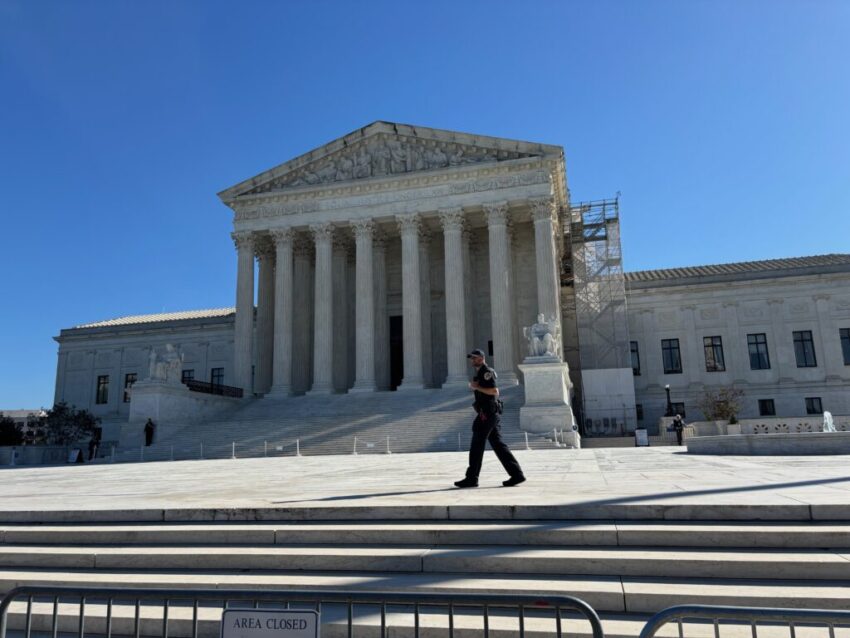The U.S. Supreme Court on Oct. 29, 2024. (Photo by Jane Norman/States Newsroom)
WASHINGTON — The Supreme Court on Thursday set aside a lower court’s ruling, allowing the Trump administration to cancel hundreds of millions of dollars in National Institutes of Health grants that addressed diversity, equity and inclusion issues.
The 5-4 ruling narrowly divided the court, with Chief Justice John Roberts, Justice Sonia Sotomayor, Justice Elena Kagan and Justice Ketanji Brown Jackson dissenting from their colleagues.
The Trump administration originally requested the Supreme Court to intervene in the case in July, when Solicitor General D. John Sauer filed an application arguing “the district court lacked jurisdiction to order the government to pay out some $783 million in terminated grants.”
Sauer wrote the case was similar to one the Supreme Court had ruled on earlier this year, determining that a district court erred when it blocked “the Department of Education from terminating DEI-related grants.”
In that case, the Supreme Court ruled that “such claims likely belonged in the Court of Federal Claims, that the district court accordingly lacked jurisdiction.”
Sauer wrote in his application to the Supreme Court that the lower courts in the NIH grants case chose to ignore the justices’ prior ruling.
“The district court’s order directs the NIH to continue paying $783 million in federal grants that are undisputedly counter to the Administration’s priorities,” Sauer wrote. “This Court has already intervened to stay a materially identical order … and the same course is even more warranted here given the district court’s brazen refusal to follow controlling Supreme Court precedent.”
Democratic AGs weigh in
Democratic attorneys general for Arizona, California, Colorado, Delaware, Hawaii, Maryland, Massachusetts, Minnesota, Nevada, New Jersey, New Mexico, New York, Oregon, Rhode Island, Washington and Wisconsin opposed the Trump administration’s request in a 49-page filing.
“The federal government’s application spins a tale of lower courts disregarding established legal guardrails to block routine agency decisions,” they wrote. “That narrative bears little resemblance to reality; indeed, it gets things exactly backward.”
The Trump administration’s decision to cancel the NIH grants, they wrote, came “without providing any meaningful explanation of their decisions.
“Defendants then executed the directives by, among other things, canceling hundreds of research grants to the plaintiff states’ public universities for projects investigating heart disease, HIV/AIDS, Alzheimer’s disease, alcohol and substance abuse, mental-health issues, and countless other health conditions.”
The American Public Health Association also opposed the Trump administration’s efforts to get the Supreme Court to throw out the lower court’s rulings.
The APHA wrote in its own filing that the Trump administration “failed to consider the reliance interests at stake—namely, the impact to researchers’ career progression, the risk to human life, and the damage to the overall scientific endeavor and the body of public health.”
Siding with Trump administration
Justices Clarence Thomas, Samuel Alito, Neil Gorsuch and Brett Kavanaugh disagreed, siding with the Trump administration and setting aside the lower court’s rulings in the case. Justice Amy Coney Barrett wrote a concurring opinion.
Gorsuch sharply rebuked the district and appeals courts in his opinion, in which Kavanaugh joined in part and dissented in part.
“Lower court judges may sometimes disagree with this Court’s decisions, but they are never free to defy them,” Gorsuch wrote. “In Department of Ed. v. California … this Court granted a stay because it found the government likely to prevail in showing that the district court lacked jurisdiction to order the government to pay grant obligations.”
Barrett appeared to agree, writing in her concurring opinion that “the District Court likely lacked jurisdiction to hear challenges to the grant terminations, which belong in the Court of Federal Claims.”
In a dissenting opinion, Jackson wrote that the justices did not take enough time to seriously consider the ramifications of their decision in the Education Department case when they spent “a mere nine days” deciding whether a federal district court or the Court of Federal Claims holds jurisdiction when the government terminates “federal grants en masse.”
“I viewed the Court’s intervention then—in an emergency stay posture, while racing against a fast-expiring temporary restraining order—as ‘equal parts unprincipled and unfortunate,’” Jackson wrote. “As it turns out, the Court’s decision was an even bigger mistake than I realized.”
Ariana Figueroa contributed to this report.
Click this link for the original source of this article.
Author: Jennifer Shutt
This content is courtesy of, and owned and copyrighted by, https://www.nevadacurrent.com and its author. This content is made available by use of the public RSS feed offered by the host site and is used for educational purposes only. If you are the author or represent the host site and would like this content removed now and in the future, please contact USSANews.com using the email address in the Contact page found in the website menu.





